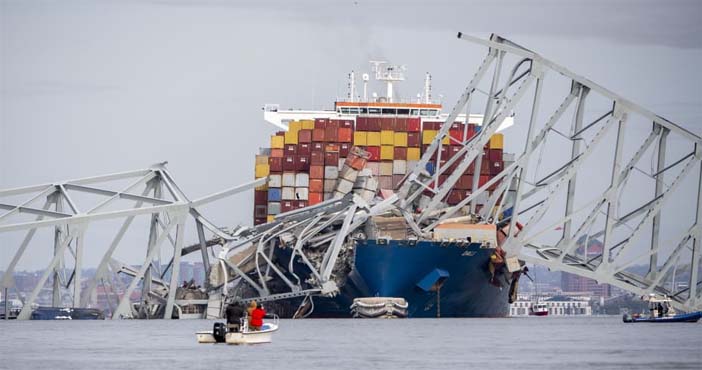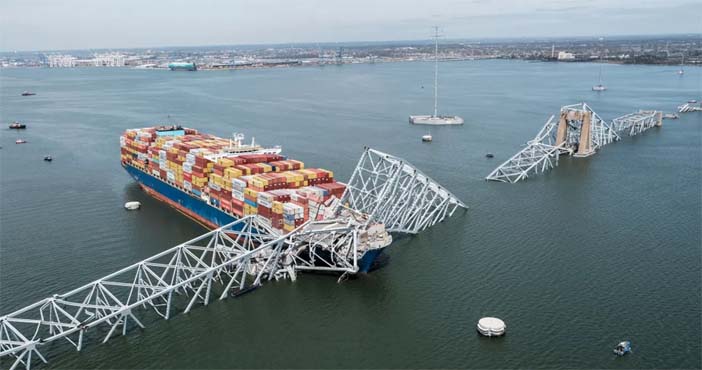

Baltimore Key Bridge collapse : On Tuesday this week, the world witnessed a devastating incident as a container ship collided with the Francis Scott Key Bridge in Baltimore, causing it to collapse. This tragic event not only blocked one of the busiest US commercial harbors but also resulted in the loss of lives and significant damage.
Shortly after a cargo container ship collided with the Francis Scott Key Bridge on March 26, the U.S. Department of Transportation’s Federal Highway Administration (FHWA) swiftly allocated $60 million in Emergency Relief (ER) funds to the Maryland Department of Transportation. These funds will kickstart the rebuilding process, with more financial assistance expected as work progresses.
U.S. Transportation Secretary Pete Buttigieg highlighted the importance of these funds in aiding Maryland’s urgent efforts to repair the bridge and resume normal operations at the Port of Baltimore following the tragic incident that claimed six lives. Federal Highway Administrator Shailen Bhatt echoed this sentiment, affirming the federal government’s commitment to supporting President Biden’s comprehensive response to the bridge collapse. The allocated Emergency Relief funding will help Maryland address traffic disruptions, supply chain interruptions, and restore everyday activities, marking the initial phase of the reconstruction process for the Francis Scott Key Bridge.
More about Francis Scott Key bridge
The Francis Scott Key Bridge, named after the author of the US national anthem, stood as an iconic structure for nearly five decades before the unfortunate incident. Built near the site where Francis Scott Key was inspired to write the national anthem, the bridge held historical significance.
Constructed in the mid-1970s, the bridge was a marvel of engineering, spanning 2.6 kilometers and handling millions of vehicles annually. However, despite its robust design, the bridge succumbed to the impact of the massive container ship, the MV Dali.
The collision occurred when the Singapore-flagged container ship Dali, measuring 948 feet in length, struck a concrete pier supporting the bridge. Despite efforts to safeguard the bridge against such incidents, including concrete dolphins and a fender designed to absorb impact, the sheer size and force of the vessel proved too much to withstand.
Why the Bridge Collapsed?
The tragic collapse of the Francis Scott Key Bridge in Baltimore raises questions about the reasons behind this devastating event. Built in the mid-1970s and opened in 1977, the main structure of the bridge over the navigation channel is a “continuous truss bridge” divided into three sections or spans.
The bridge is supported by four piers, two on each side of the navigable waterway. These two piers play a critical role in protecting against ship impacts.
To provide protection, two layers of defense were in place: concrete structures known as “dolphins” and a fender. The dolphins, positioned about 100 meters upstream and downstream of the piers, are designed to absorb the energy of a wayward ship, sacrificing themselves to prevent it from hitting the bridge.
The fender, made of timber and reinforced concrete, surrounds the main piers, serving as an additional barrier to absorb impact energy. However, fenders are not designed to withstand impacts from very large vessels. When the MV Dali, weighing over 100,000 tonnes, breached the protective dolphins, the fender proved inadequate to withstand its immense size and force.
Video evidence suggests that the cloud of dust observed just before the bridge collapsed may have been the fender disintegrating under the pressure of the ship.
Once the massive vessel bypassed both the dolphin and the fender, the pier, one of the bridge’s four main supports, was unable to withstand the impact. Considering the size of the vessel and its estimated speed of approximately 8 knots (15 kilometers per hour), the impact force was estimated to be around 20,000 tonnes.
The collapse of the Francis Scott Key Bridge was the result of a series of factors, including the failure of protective measures to withstand the impact of a large vessel like the MV Dali.
d just before the bridge collapsed may have been the fender disintegrating under the pressure of the ship.
Once the massive vessel bypassed both the dolphin and the fender, the pier, one of the bridge’s four main supports, was unable to withstand the impact. Considering the size of the vessel and its estimated speed of approximately 8 knots (15 kilometers per hour), the impact force was estimated to be around 20,000 tonnes.
The collapse of the Francis Scott Key Bridge was the result of a series of factors, including the failure of protective measures to withstand the impact of a large vessel like the MV Dali.













